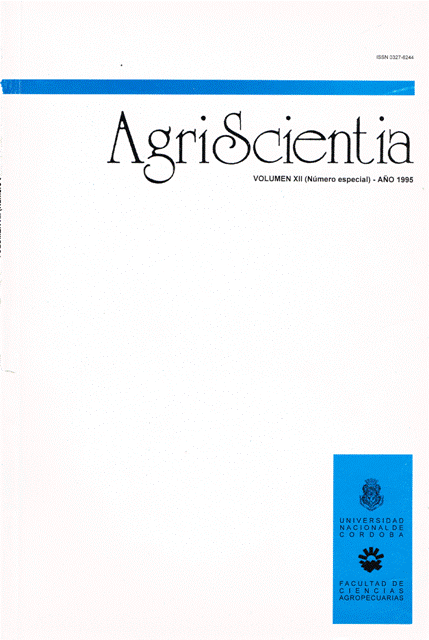Agrohydrological aspects of tomato and bean crops in Oran (Salta), Argentina.
Main Article Content
Abstract
The objective of this paper is to evaluate first tomato and dry bean cultivation management for exportation in Orán, through the hydrologic daily balance in relation with complementary irrigation necessities. With the pluviometric data of the location of Orán, three hydrologic daily balances were made, simulating different soil managements: natural pasture, green manure - cultivation of tomato, and green manure - cultivation of bean. Subsequently, the obtained series of water storage in the soil was analyzed, and the probability of absolute drought, conditional drought, and optimum humidity was calculated for every decade of the year. Then, for the critical periods and for the entire cycle of each crop, the possibility of application of complementary irrigation was studied. The consecutive mean water storage simulation values showed a greater frequency of drought periods at the beginning of the century than in the last decades, which presented an increment in precipitation data.
Article Details
Section

This work is licensed under a Creative Commons Attribution-ShareAlike 4.0 International License.
How to Cite
References
Damario, E. A., & Cattáneo, C. (1982). Estimación climática de la evapotranspiración potencial en la Argentina según el método de Penman 1948. Revista Facultad de Agronomía, 3(3), 271-292.
Del Barrio, R. A., Forte Lay, J. A., & Troha, A. (1987). Utilización de un balance hidrológico diario para la estimación de las necesidades de riego complementario en los cultivos de trigo y maíz en la región pampeana. GEOACTA (AAGG), 14(1), 131-140.
Doorembos, J., & Pruitt, W. O. (1990). Las necesidades de agua de los cultivos (Estudio FAO: Riego y Drenaje N° 24). FAO.
Falasca, S., Forte Lay, J. A., & Zabala, S. M. (1993). Características agrohidrológicas de la localidad de Orán. III Congreso "El NOA y el Medio Ambiente", San Salvador de Jujuy. (En prensa).
Forte Lay, J. A., & Del Barrio, R. A. (1983). Método para la estimación de necesidades de riego complementario en la región pampeana. En Actas del XI Congreso Nacional del Agua (Tomo IV, pp. 127-149). Córdoba, Argentina.
Frére, M. (1972). A method for the practical application of Penman formula for estimation of potential evapotranspiration and evaporation from free water surfaces (FAO-AGP: AS/1972/2). FAO.
Hagan, R. M., & Steward, J. I. (1972). Water deficits - irrigation design and programming. ASCE Journal of Irrigation and Drainage.
Instituto Nacional de Tecnología Agropecuaria (INTA). (1990). Atlas de Suelos de la República Argentina (Vol. II, pp. 285-349). INTA.
Salter, P. J., & Goode, J. E. (1967). Crop response to water at different stages of growth (Research Review 2). Commonwealth Agricultural Bureau.
Taylor, S. A. (1952). A use of mean soil moisture tension to evaluate the effect of soil moisture in crop yields. Soil Science, 74, 217-226.
Tschapek, M. (1966). El agua en el suelo (Manuales de Ciencia Actual N° 2). Madrid, España: Alianza Editorial.
Vargas Gil, J. R., & Bianchi, A. R. (1981). Regiones Naturales del NOA. Memoria Anual de Información Técnica para Productores, INTA, Salta.





